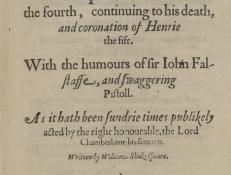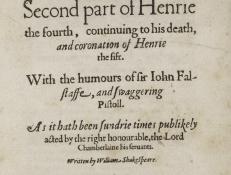To view a sortable list, please visit the Resource
All Documents
1600
Like other plays from the period, Shakespeare's plays were meant to be read both as stories and as sources for sententiae, or memorable aphorisms.
1600
This is the first edition of Henry IV, Part 2, printed in 1600 by Valentine Simmes for Andrew Wise and William Aspley, who entered it into the Stationers’ Register on August 23, 1600, along with Much Ado About Nothing.
1600
This is the variant of the first edition of Henry IV, Part 2, printed in 1600 by Valentine Simmes for Andrew Wise and William Aspley, who entered it into the Stationers’ Register on August 23, 1600, along with Much Ado About Nothing
August 23, 1600
On August 23, 1600, William Shakespeare's name appears in the Stationers' Register as "Mr Shakespere." This is the first of the four times Shakespeare's name appears in the Stationers' Register during his lifetime.
1609- 1610
The poet and courtier Sir John Harington left behind tantalizing lists of plays written by Shakespeare, Ben Jonson, Thomas Middleton, Thomas Heywood, and others. Around 1609 he compiled two lists of play quartos almost certainly in his personal collection.
circa 1623
In 1623, the antiquarian Sir Edward Dering turned the two parts of Henry IV into a single play, cutting 3000 lines from both. Dering’s adaptation is the earliest known manuscript copy, and first documented amateur performance of, a Shakespeare play (or rather, parts of two plays).
1625
The antiquarian Richard James (1592-1638), fellow of Christ Church College, Oxford, explains in this dedicatory letter to Sir Henry Bourchier why Shakespeare changed the character originally named “Sir John Oldcastle” to one named “Sir John Falstaff” in Henry IV, Parts












